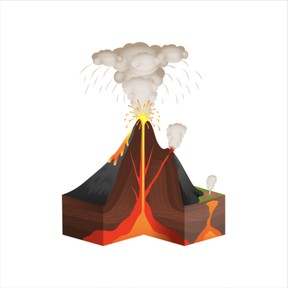
Thermal energy during a chemical reaction
I can describe endothermic and exothermic chemical processes.



8,000 schools use Gynzy
92,000 teachers use Gynzy
1,600,000 students use Gynzy
General
In this lesson, students will watch a volcano reaction and learn about endothermic and exothermic chemical processes. (Procedures for this are listed below, and a video is included in the lesson in case the materials are not available.)
Standards
NGSS:
MS-PS1-6
MS-PS1-2
MS-PS1-4
Learning objective
Students will be able to describe endothermic and exothermic chemical processes.
Introduction
The teacher will place vinegar into a beaker with a thermometer and note the temperature. The teacher will then add baking soda to the vinegar. Students will observe the chemical reaction and pay close attention to the temperature. They will predict what happened with regards to the reaction and temperature.
Instruction
Students will learn the differences between exothermic and endothermic reactions and how these types of reactions release or absorb heat. They will also learn how energy is conserved in these reactions—the heat energy is transformed into or from chemical bonds.
Students will learn about activation energy, energy diagrams, and what exothermic and endothermic reactions look like on those diagrams. Students will have the opportunity to draw energy diagrams for a few chemical reactions.
They will then talk about the different ways the rate of reaction can be changed (concentration, adding heat, surface area, catalyst).
Quiz
Review the lesson concepts with 10 multiple-choice questions.
Closing
Students will recall what they learned about endothermic and exothermic reactions. They will also fill out an exit slip.
Teaching tips
For the instructor:
1) Place about 50 mL of vinegar in a clear cup or 500 mL beaker.
2) Insert thermometer (or ideally temperature probe). Ask one student to read the temperature. This student will read out the temperature every 10 seconds as the reaction proceeds.
3) Instruct all other students to record their observations/thoughts and the temperature that is called out every 10 seconds.
4) Add approximately 1 tablespoon of baking soda to the cup and swirl.
5) The reaction should be completed after 1 minute. Ask students to work with a partner to answer the discussion questions (next slide).
If unable to do the demonstration, students can watch the video in the lesson, then answer the discussion questions.
The online teaching platform for interactive whiteboards and displays in schools
Save time building lessons
Manage the classroom more efficiently
Increase student engagement
Discover more!
About Gynzy
Gynzy is an online teaching platform for interactive whiteboards and displays in schools.
With a focus on elementary education, Gynzy’s Whiteboard, digital tools, and activities make it easy for teachers to save time building lessons, increase student engagement, and make classroom management more efficient.



